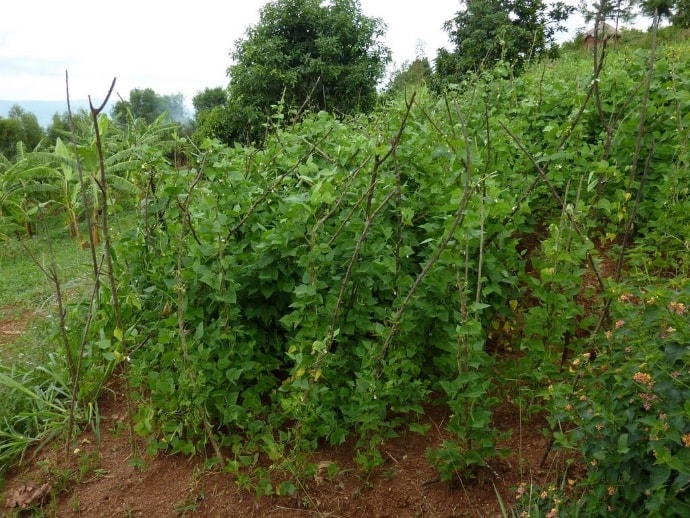By Karl Weyrauch, Founder, Pygmy Survival Alliance
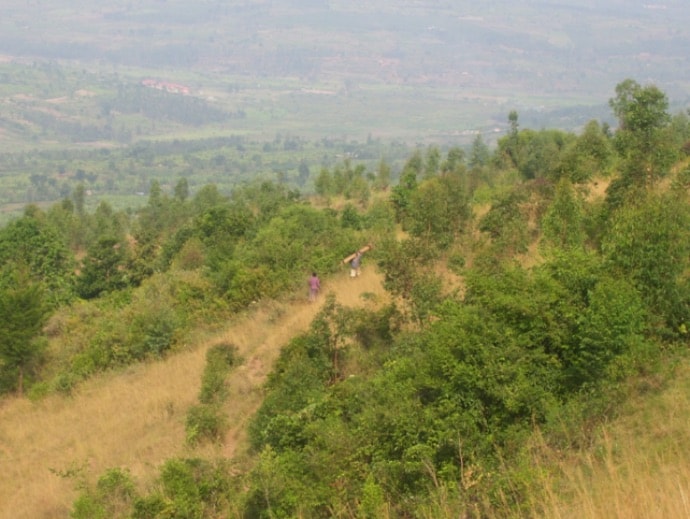
Bwiza Hillside 2009. Photo: K. Weyrauch
To most people in Rwanda, Bwiza Village was a place unseen, and to the outside world, it was less than that. It was both unseen, unheard of, and mostly unimaginable. Yet, the name “Bwiza” in Kinyarwanda, the national language of Rwanda, translates as “something good” and a place named “Bwiza” would essentially mean “a good place”. Clinging to the eastern slope of an unnamed hillside in Gasabo District, in the eastern-most part of the city of Kigali, Bwiza in 2009, was home to about 30 Batwa families who lived in a couple dozen stick and thatch huts scattered like buckshot across two ravines splitting the ridge like cracks in a loaf of crusty peasant bread.
Although Bwiza was a place of fine views and cool breezes, it had one major drawback: there was hardly any food to eat, and hardly any way to get food. As one villager told us: “The way we used to live was so bad… it was living like animals. We lived in a bad way there … This was our way of living. This was our life.” Because people often went days without eating, starvation contributed to the death of many infants and children. So many, in fact, that about half of the babies born did not live to see their fifth birthday.
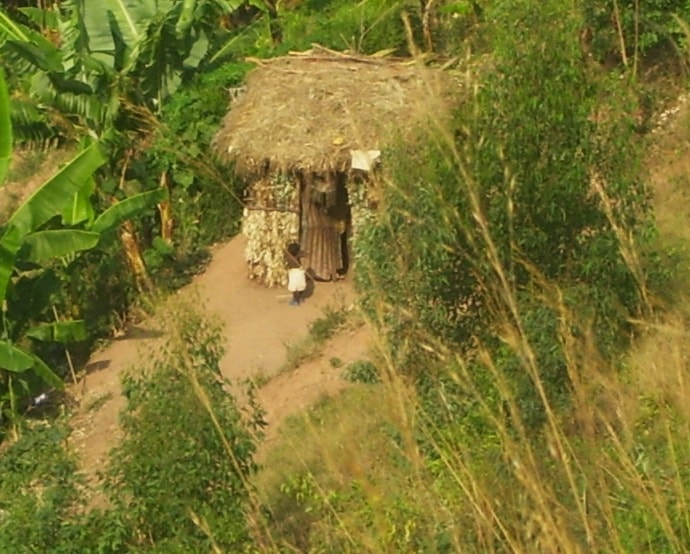
Bwiza House 2009. Photo: K. Weyrauch
The soil along the ridge was a thin mixture of sandy dirt and gravel. Comprised of eroded metamorphic rock known as granitic gneiss, without much organic substrate, it did not hold water well, was very hard to dig, and was especially ill-suited for agriculture. The sloping topography led to areas of extreme water runoff, creating steeply angulated, rocky gullies. There were scattered areas of scrubby eucalyptus trees and interspersed pockets of grassy terrain, the largest of which was at the top of the ridge and served as a small playfield where young people sometimes kicked around a ball made of twine and rags. Some of the exposed earth was rich in clay and there were really no crops people knew how to cultivate. In fact, most people believed the land could not sustain any agricultural production at all, and they were mostly correct.
Yet, Bizimungo Muhamad, a relative newcomer to Bwiza, taught us all something important. Having travelled in his career as a construction worker and mason more than most of his neighbors, he had also converted to Islam. Latifeh, one of his wives, lived in Bwiza and always wore a cloth that covered her head, in contrast to the other women. Years later, she became the village health worker and was also known for growing the biggest cabbage anywhere.
Muhamad had learned that just a spoonful of cow manure, when planted in the same hole as a seed, would foster the seed to sprout and grow, even under harsh conditions. By planting a few palm trees near his house using this technique, the trees had gotten to be about a foot tall and remarkably, they were the only such trees anywhere on the ridge. His experiment convinced others that cow manure was a good thing for plants, even in the unforgiving soil of Bwiza, and maybe worth a try. The biggest problem was that there were few flat places available for planting, no tools to till the hard earth, and of course there was no water available for irrigation.
To circumvent these barriers to growing crops, some landscape engineers from America and some local advisers involved in rural development in western Rwanda, a place with both higher elevation and steeper slopes than in Bwiza, observed that terracing the contours of the hills was a well understood solution to increase tillable farmland. It had been used around the world and was as ancient as the Babylonians, yet in 2009 it was still new to Bwiza. The advantages of terracing were that water runoff and soil erosion could be minimized, thus increasing soil fertility; and larger land area could be devoted to cultivation, thus increasing food production. The villagers were accustomed to hard work, as many picked up odd jobs on nearby construction projects, and others labored in the stone quarry at the far side of the ridge. Now all they needed was tools, some training, and a plan.
In July 2009, Bwiza Village set up their Terrace Committee. It was comprised of Claudine Mbabazi and Jean Marie representing the Village Council, Muhammad the manure experimenter and mason, and Valens, one of the chief quarry workers. There were eleven men in the village who signed-on as laborers, and together the community worked out the details of a plan. The Terrace Committee would provide planning and oversight, and the men would procure stones, sand, and labor. Pygmy Survival Alliance would donate tools, cement, manure, and training in the construction of agricultural terraces. In exchange for a day’s work, each man would receive 1 kg of cassava flour and 1 kg of beans, worth at the time about 580 Rwandan francs— seventy US cents. To seal the deal, we drew up a contract between PSAA and the Terrace Committee and everyone signed it.
We began shopping for tools and eventually collected four shovels, four hoes, two sledgehammers, two picks, and one large pry bar. We brought the tools to the village, and unloaded them from the pickup, but before handing them over to the workers, we held a brief meeting.
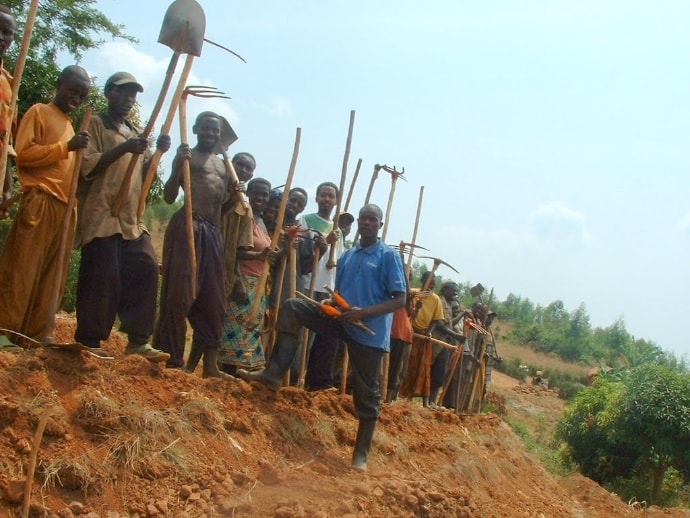
Tools Are Friends. Photo: K. Weyrauch
“What are these?”, I asked the men.
“These are tools, they said, shovels and hoes and like that.”
“No”, I replied, “These are your future. A future free from hunger. For you and your children and wives. Guard these tools so they don’t go missing. Or else, you will continue to go hungry, like you are now. And worse, that hunger won’t go away.” They nodded and murmured in agreement. We drove away with our fingers crossed, since many Rwandans had told us—with a scoff and a shrug—that the Batwa could not be trusted with any material goods; that they would go sell whatever they had and buy beer; that they would not cooperate; and that it was no good trusting them, because they were just not trustworthy.
Ten days later, terrace construction was booming.
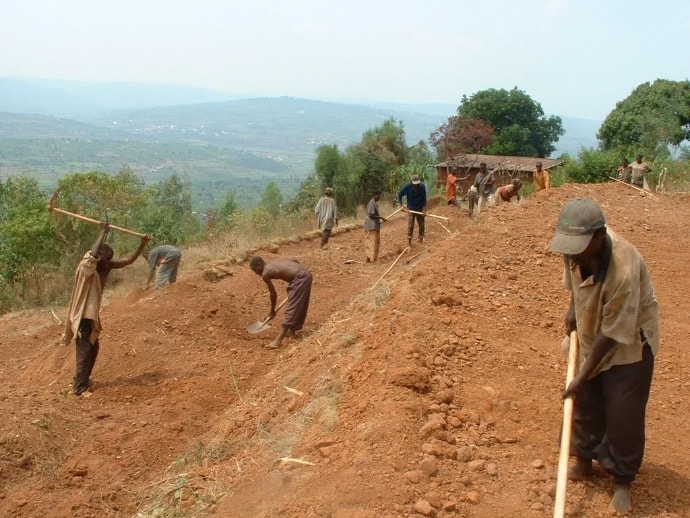
The men liked to see the progress and the village was excited to see the tangible possibility that new arable land would yield significantly more food. That’s when trouble hit, and Eddy, our field manager, came to report the news.
“One of the shovels went missing”, he said. “Now what?”
“Hmmm,” I replied. “They need to fix this problem. Please go back and tell them we are very disappointed. Tell them that somehow, they will need to come up with the missing shovel, because they promised to take care of the tools. Otherwise, there will be consequences.” We had no idea what kind of consequences, and no plan how to sort this out. We hoped that Eddy could do his magic and make everything better.
The next day, Eddy came back, smiling. “They fixed it”, he said.
“How?”, we asked, feeling both surprised and a bit giddy.
Eddy said, “I went there and told them that we were all very disappointed about one of the shovels going missing.” I told them, “There will be serious consequences if that shovel is not recovered.” Then he told us that the men started to shout and debate among themselves and finally, they came up with a plan. They said they were going to search the village for the missing shovel and when they found it, they would burn down the house where they found it and then throw the owner out of the village. They went to the first house and searched…no shovel. They went to the second house…no shovel, they walked past the village square on the way to the third house and then one of the men cried out, “There it is, in the bushes!”
The village people themselves had found the shovel on their own terms, with their own plan and their own successful implementation. Their plan had worked. And after that, no tools ever went missing again. They had demonstrated a collective ability to make decisions and implement solutions that were both culturally appropriate for their community and highly effective. Most impressively, they had succeeded using what we considered to be novel tactics that never would have been considered a viable option by a U.S.-based nongovernment organization.
This success led to a cascade of benefits. The terrace-building continued, bean seeds were planted, and the first harvest provided enough beans to feed people for months, thus proving that now Bwiza Village had acquired skills to grow significant food crops on their own land for the first time, ever. As the chief’s daughter later said, “We are the first Batwa to make terraces, and to bring hoes and food…. We are farmers.”
